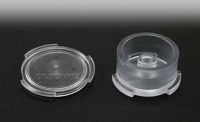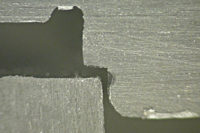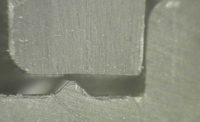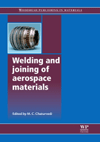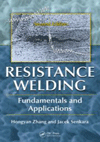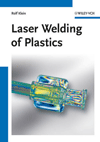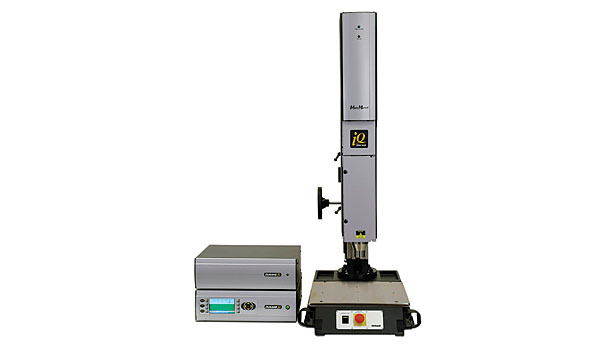More Control for Ultrasonic Welding
The latest technology for ultrasonic plastic welding provides better process control and the tools to handle more part variations.










Alot can happen in 0.5 second, especially in the world of assembly. One or more rivets can be simultaneously inserted. Multiple beads of adhesive can be
| Jump to: |
dispensed. And two thermoplastic pieces can be ultrasonically welded into a usable part.
For more than 30 years, ultrasonic welding has been a popular method for assembling parts made of amorphous or semicrystalline thermoplastic or thermoplastic composites. Ultrasonic welding is a form of friction welding that joins parts together by vibrating them against each other.
All ultrasonic welders feature a power supply (generator), computer controller, actuator (driven by a pneumatic cylinder or servo-driven ballscrew), transducer, booster and sonotrode horn. The transducer, booster and horn make up the ultrasonic stack.
Power is sent to the transducer, which contains piezoelectric crystals that expand and contract. This action causes mechanical vibrations that the booster increases and transfers to the horn, which, in turn, transfers ultrasonic energy to the joint interface.
Heat is generated at the joint through a combination of friction and hysteresis. The heat melts a small amount of plastic on each part. When the ultrasonic vibrations stop, the molten material solidifies and the weld is achieved. Actual weld time is usually between 200 and 400 milliseconds.
Besides speed, manufacturers like that ultrasonic welding is clean and economical, especially for small parts. They also like that suppliers are developing machines that give them more process control and the ability to weld complex plastic parts.
For example, Herrmann Ultrasonics Inc. has developed a composite sonootrde that enables a European auto supplier to ultrasonically weld daytime running lights with a 3D shape. The composite sonotrode consists of a sonotrode carrier and several sonotrode tips, each of which is designed and tuned as a stand-alone unit.
The tips are of different heights that are designed to match the part contour during welding. To ensure correct vibration of each tip, it is mounted in the carrier, manually adjusted and gauged for frequency. To guarantee correct vibration of the composite sonotrode, it is tuned for frequency, minimum idling power and even amplitude distribution. The composite horn is then laser gauged under load simulation. Required corrections are performed by a machine.
“The real growth period for ultrasonic welding came in the 1980s and 1990s,” says Bill Reed, sales and marketing director for Extol Inc., which integrates ultrasonic welding machines and also makes spin, infrared and hot-plate welding systems. “Today we’re in an era of refinement.”
Taking Control
Manufacturers can control every key parameter of the ultrasonic welding process: amplitude, weld time, hold time, energy, power and distance. Current technology enables operators to precisely program these parameters into the controller of handheld, benchtop, automated and robotic systems.
Amplitude is the peak-to-peak motion of the horn at its face. Branson Ultrasonics Corp. has an amplitude profiling system that enables users to instantaneously increase or decrease horn amplitude during the weld.
“Let’s say weld time is 250 milliseconds, and that it takes 150 milliseconds to reach the melt temperature,” says Jeff Frantz, director of marketing and product development for Branson Ultrasonics Corp. “Amplitude profiling allows us to turn down amplitude at that point and hold melt temperature for another 100 milliseconds, resulting in stronger welding at the molecular level with less flash and part marking. This feature is being used more across all industries, but especially by medical and consumer electronics manufacturers for their higher-end products.”
Branson X-Port is a Windows application that lets operators track the welding process in real time. It provides detailed data so weld fluctuations can be immediately recognized and corrected. Displayed parameters include weld time, energy and force; absolute distance; velocity; total and weld collapse; and peak power.
The company also offers a Start Ramp feature on its higher-end machines, like the DCX and 2000X series. This feature lets engineers easily program ramp up and ramp down times for increased throughput.
Dukane Corp. makes both pneumatic and servo ultrasonic welding systems. All of its servo welders feature an HMI that enables operators to control 10 welding parameters. The welders also are equipped with Melt Detect and Melt-Match technologies.
“Controlled, consistent velocity of the ultrasonic stack produces a steady melt rate, which creates a homogenous molecular structure, a stronger weld and
“Controlled, consistent velocity of the ultrasonic stack produces a steady melt rate, which creates a homogenous molecular structure, a stronger weld and reduced stress in the welded assembly." |
reduced stress in the welded assembly,” says Leo Klinstein, director of engineering for Dukane Corp.
Melt Detect is enabled at the start of the weld to ensure complete initiation of melt. The horn moves down until the set trigger force is registered. Ultrasound is then initiated. Once the desired drop in trigger force is detected—signaling that the parts have begun to melt and collapse—the horn resumes downward movement and compresses the part for the programmed weld.
This feature is recommended for applications where it is difficult to achieve the required amplitude to melt the parts. These include parts larger than 4 inches wide, polyamide or polyoxymethylene semicrystalline parts, and those with a small initial contact area at the joint.
Melt-Match is enabled during the weld so the ultrasonic stack velocity precisely matches the melt flow velocity of the plastic material. Klinstein says the technology offers operators precise control down to 0.0001 inch.
“Our customers are increasingly hands-on and desire more control over many process variables,” says Uwe Peregi, general manager of Herrmann Ultrasonics. “They also want to be able to quickly compare the welds of similar and different parts.”
Users of Herrmann’s hybrid (pneumatic and servo) HiQ speed-controlled Dialog welders can view weld information on the machine’s interface. It displays data or graphs that visually represent the entire weld cycle. Welding data can be viewed, analyzed, collected and downloaded onsite, or continuously sent to multiple plants or corporate offices for analysis.
The company also makes pneumatic welders, such as the Modular Punch Welding (MPW) system. This dual-purpose machine is used by several U.S. and European automakers to continually punch out a membrane disc (6 to 22 millimeters diameter) and weld it to the inside of an LED light housing. The membrane, also called a Pressure Balancing Element, prevents condensation from getting inside the housing and allows air to escape to keep the inside cool.
After a die-punch assembly cuts out a disc, it is transported by vacuum to the housing. Cycle time is less than 2 seconds.
Prior to the MPW system, automakers used glue or heat sealing to secure the membrane. Both methods were labor intensive, took much longer, required precut discs and did not allow sophisticated process control. A worker applied glue to the tiny disc then carefully placed and pressed it into the housing. Or, the worker applied heat to the specific housing area prior to pressing the membrane into softened plastic. Unfortunately, residual heat often damaged the membrane fibers.
Part Parameters
Manufacturers have little control over operating frequency, which can only be changed by changing the ultrasonic stack. For many years, the most common system frequency was 20 kilohertz. That’s no longer the case.
Mike Johnston, vice president of sales and marketing for Dukane Corp., says more customers are using 15-kilohertz systems because they need to weld larger parts. Dukane offers 15- and 20-kilohertz systems with a pneumatic or servo actuator and a 4,800-watt generator—its largest ever.
“Finite element analysis helps us design better horns to weld larger parts,” says Johnston. “But practically speaking, the horn shouldn’t be bigger than 10 by 8 inches.”
Higher-frequency systems of 30-, 35- and 40-kilohertz continue to be used for smaller, delicate parts. Dukane makes 50- and 70-kilohertz systems (pneumatic or servo) for welding mini components.
One European medical-device manufacturer is using the 70-kilohertz servo system to weld an ultra thin component (100 micrometers) inside a very thin testing device (300 micrometers). Welding distance is 50 micrometers, and cycle time is less than 0.5 second. The system has been in operation for several months without damaging any components or devices.
Appliance and auto manufacturers like the Ultraplast digital generator because it won’t overheat in extreme operating conditions. Made by Herrmann, the generator outputs up to 1,200 watts at 35 kilohertz and up to 6,200 watts at 20 kilohertz. It can be configured for fast intermittent welding of midsized and large parts. The generator is available for use with 20-, 30- and 35-kilohertz HiQ welders.
The need to weld larger parts is not the only reason suppliers have increased the power of their generators. Another reason is that thermoplastic materials are increasingly being custom blended for manufacturers.
“Parts made of thermoplastic with new base resins or resin mixes present challenges for suppliers,” says Frantz. “These parts have higher heat capabilities, and they require more power to weld. Manufacturers of consumer electronics products often use these thermoplastics.”
Branson has significantly increased the capacity of power supplies used with its 20-kilohertz system. In 2008, the system was available with 1,000-, 2,000- and 3,000-watt power supplies. Today it can be used with 1,250-, 2,500-, 4,000- and 5,500-watt power supplies.
Sonobond Ultrasonics Inc. offers the Standard 3000, a 20-kilohertz system that can weld a wide range of part sizes. Janet Devine, president of Sonobond Ultrasonics Inc., says the system features a converter that can be used with generators up to 3,000 watts. It offers all the features needed for complete process control.
Robotics and Automation
Ultrasonic robotic welding of plastic has not increased in recent years, say suppliers. They cite two reasons for this.
“Many end-users prefer using an actuation system to a robot for larger parts because the stack is too heavy and slows down the robot’s arm too much,” says Peregi. “We’ve seen a decline of six-axis-robots integrated with 15- or 20-kilohertz systems. Manufacturers seem to prefer using robots with lighter stacks for 35- or 40-kilohertz systems.”
Another problem with robots is that they generally produce backlash or deflection, says Reed. Additionally, robotic movement has difficulty producing the dynamic follow-through necessary for a high-quality ultrasonic weld.
“As a result, robots are best for ultrasonic spot welding or staking, rather than conventional welding,” says Reed. “Staking or spot welding intentionally disturb the surface on contact and are usually done on the B side of a part. A conventional ultrasonic weld is one in which horn contact is not visibile.”
Ultrasonic robotic welding tends to be used for large plastic parts that require several welds, such as door panels. Often times, these robotic systems incorporate multiple welding horns that can be easily programmed and changed. Welding parameters can also be programmed and changed as needed.
Non-robotic automated applications often involve several ultrasonic stacks. Dukane’s iQ series has a Trigger by Power feature that enables manufacturers to control the force of each stack in multi-stack or robotic applications. Johnston says the technology improves cost-effectiveness and weld repeatability.
Some automated applications present an opportunity for suppliers to help engineers increase their productivity through shorter cycle times. For example, Klinstein says a prospective customer has mounted an ultrasonic welder to a gantry crane so it can be quickly moved among welding locations.
The customer is using a competitor’s pneumatic welder, and each weld takes 1.20 seconds. Klinstein says a servo welder can cut the cycle time by 0.25 second, to 0.95 second.
Like automakers, furniture manufacturers often use automated systems that perform multiple welds on one part or simultaneous welds on multiple parts. Reed says this is because ultrasonic welding is great for joining fabrics to plastic.
“One U.S. office furniture maker we work with uses a 20-kilohertz automated system with 18 actuators to spot weld fabric to chair backs,” says Reed. “Before considering ultrasonics, the assembly options the company had were staples, glue or a separately molded complex component that would retain the fabric.”
Reed says manufacturers need to work closely with their ultrasonic equipment supplier and integrator to make an automated application successful. He also wants manufacturers to understand that automated applications present a significant challenge to integrators.
“We want the end-user to have the same level of welding control in their automated process as they used in the development phase of the project. In some cases, the components offered from ultrasonic welding suppliers for automation use are not of the same capability as the refined benchtop units. Intentional dialogue between the three parties can address these challenges.”
Looking for a reprint of this article?
From high-res PDFs to custom plaques, order your copy today!



